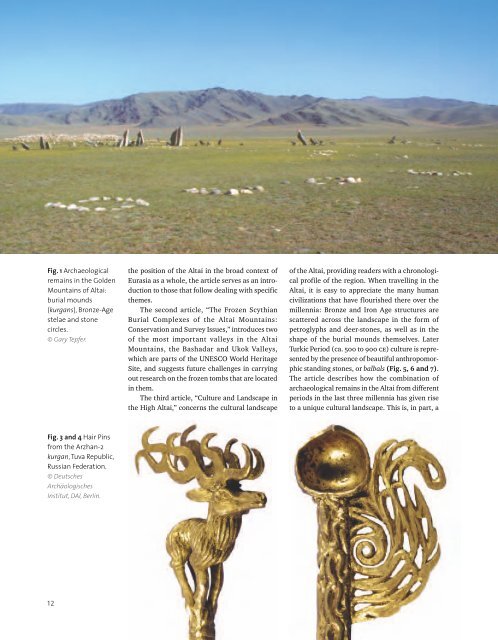Scythian Culture - Preservation of The Frozen Tombs of The Altai Mountains (UNESCO)
Create successful ePaper yourself
Turn your PDF publications into a flip-book with our unique Google optimized e-Paper software.
Fig. 1 Archaeological<br />
remains in the Golden<br />
<strong>Mountains</strong> <strong>of</strong> <strong>Altai</strong>:<br />
burial mounds<br />
(kurgans), Bronze-Age<br />
stelae and stone<br />
circles.<br />
© Gary Tepfer.<br />
the position <strong>of</strong> the <strong>Altai</strong> in the broad context <strong>of</strong><br />
Eurasia as a whole, the article serves as an introduction<br />
to those that follow dealing with specific<br />
themes.<br />
<strong>The</strong> second article, “<strong>The</strong> <strong>Frozen</strong> <strong>Scythian</strong><br />
Burial Complexes <strong>of</strong> the <strong>Altai</strong> <strong>Mountains</strong>:<br />
Conservation and Survey Issues,” introduces two<br />
<strong>of</strong> the most important valleys in the <strong>Altai</strong><br />
<strong>Mountains</strong>, the Bashadar and Ukok Valleys,<br />
which are parts <strong>of</strong> the <strong>UNESCO</strong> World Heritage<br />
Site, and suggests future challenges in carrying<br />
out research on the frozen tombs that are located<br />
in them.<br />
<strong>The</strong> third article, “<strong>Culture</strong> and Landscape in<br />
the High <strong>Altai</strong>,” concerns the cultural landscape<br />
<strong>of</strong> the <strong>Altai</strong>, providing readers with a chronological<br />
pr<strong>of</strong>ile <strong>of</strong> the region. When travelling in the<br />
<strong>Altai</strong>, it is easy to appreciate the many human<br />
civilizations that have flourished there over the<br />
millennia: Bronze and Iron Age structures are<br />
scattered across the landscape in the form <strong>of</strong><br />
petroglyphs and deer-stones, as well as in the<br />
shape <strong>of</strong> the burial mounds themselves. Later<br />
Turkic Period (ca. 500 to 900 ce) culture is represented<br />
by the presence <strong>of</strong> beautiful anthropomorphic<br />
standing stones, or balbals (Fig. 5, 6 and 7).<br />
<strong>The</strong> article describes how the combination <strong>of</strong><br />
archaeological remains in the <strong>Altai</strong> from different<br />
periods in the last three millennia has given rise<br />
to a unique cultural landscape. This is, in part, a<br />
Fig. 3 and 4 Hair Pins<br />
from the Arzhan-2<br />
kurgan, Tuva Republic,<br />
Russian Federation.<br />
© Deutsches<br />
Archäologisches<br />
Institut, DAI, Berlin.<br />
12
















